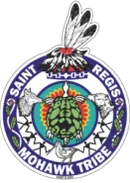Tribe Seeks Similar Technology for Membership Cards
AKWESASNE — The Saint Regis Mohawk Tribal Council is notifying community members that U.S. Customs and Border Protection (CBP) has extended the 2D Barcode Pilot Program at the Massena Port of Entry. The barcode reader will continue to permit travelers to utilize the barcodes located on the back of standard driver’s licenses for expediting border crossings, while the Tribe explores similar technology for tribal membership cards.
On Tuesday, July 10th, representatives of the Massena Border Station met with the Tribal Council to discuss implementation of a 30-day 2D Barcode Pilot Program. The Massena Port of Entry was the first border crossing nationwide to utilize new technology designed to automatically capture information from 2D barcodes. It was implemented to eliminate the need for border officers to manually type information and reduce time processing border crossings.
During the discussion, the ability to utilize the tribal identification card was considered however, the card currently lacks a 2D barcode on the backside. As a result, the Office of the Tribal Clerk is currently exploring the barcode technology for possible inclusion on membership cards. More information on this new feature for tribal identification cards will be shared in the future.
The two dimensional (2d) barcode is a standardized format printed on the back of state and provincial driver’s licenses, as well as other documents. It follows a formatting sequence that can store information in a format that can be quickly read by automated technology. The concept is similar to QR and UPC codes routinely encountered in our daily lives, such as at grocery stores.
The readers quickly capture information coded within the standardized barcode printed on the back of regular driver’s licenses, which is also utilized by state and local law enforcement, as well as some retail vendors. The information that is automatically retrieved is the same information listed on the front of a driver’s license, with CBP noting they are only utilizing information needed to perform their primary inspections.
The Massena Port of Entry reports the 30-day pilot period earlier this summer saw a 3,000 percent increase in the usage of state or provincial driver’s licenses as identification. In July 2018; 5,530 driver’s licenses were presented compared to 177 driver’s licenses in July 2017. This increase in readable documents significantly cut down primary processing time, particularly for Akwesasne Mohawks who comprise the majority of border travelers. Given its success, the 2D Barcode Pilot Program has been extended for an indefinite time.
At this moment, border travelers at the Massena Port of Entry who do not possess a driver’s license, including children, or have another government-issued identification card will continue to be processed manually. As well, tribal identification cards, Indian status cards, red cards and passports will continue to be accepted.
The Saint Regis Mohawk Tribe is continuing to provide this information as an option, as it continues to explore additional means of facilitating border crossings in accordance with our inherent rights, as recognized by treaty and statutes.
PHOTO CAPTION: The Saint Regis Mohawk Tribal Council was notified by the Massena Port of Entry that the 2D Barcode Pilot Program has been extended, which allows border travelers to present driver’s licenses to expedite primary processing. Pictured is Tribal Clerk Summer Bero, who is helping lead efforts to incorporate similar technology on tribal identification cards for the continued recognition of inherent border crossing rights.
#####
The Saint Regis Mohawk Tribal Council is the duly elected and federally recognized government of the Saint Regis Mohawk People.

